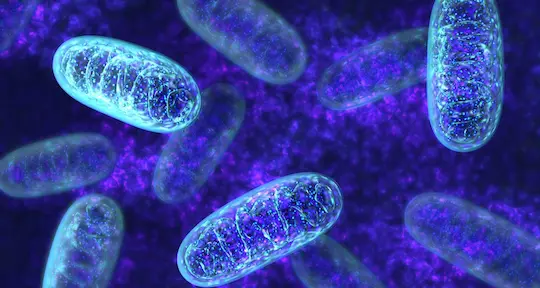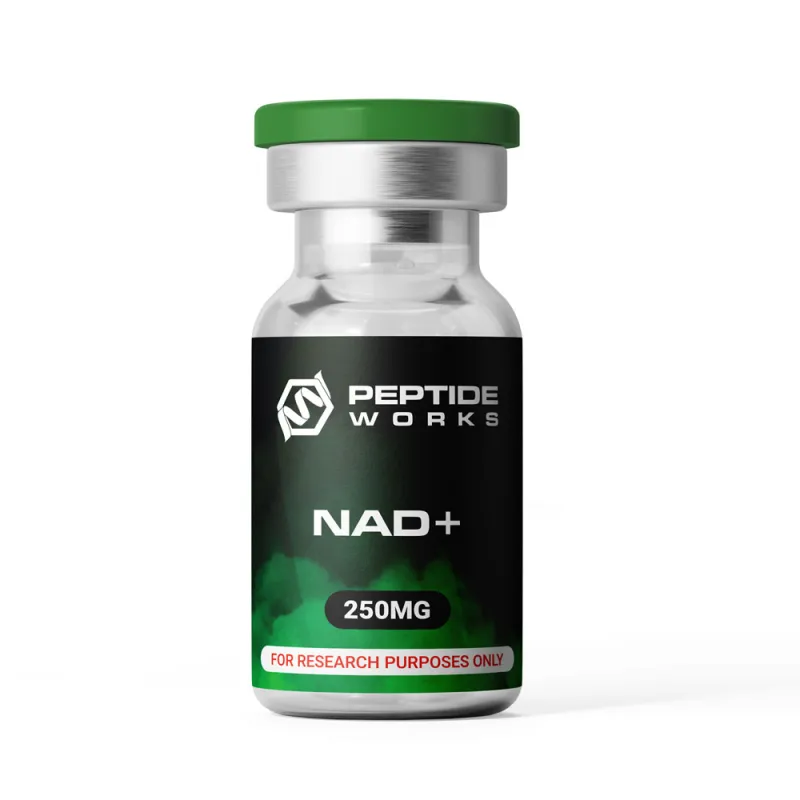
PROMO!
First order? Get 10% OFF with this code: 1storder

Energy is the driving force behind focus, movement, and recovery. When cells have less energy to work with, the body quickly feels the effects slower performance, weaker endurance, and reduced repair. Because of this, there is growing interest in compounds that help explain how the body maintains vitality at the cellular level.
One compound that stands out in this research is NAD+ (nicotinamide adenine dinucleotide), a coenzyme found in every cell that helps turn nutrients into usable fuel. NAD+ supplements, studies are also looking at peptides such as Tesofensine and Sermorelin, which may provide additional insights into energy balance, metabolism, and recovery. This article takes a closer look at each of these and how they connect to the bigger picture of energy support.
Explore NAD+ supplements from Peptide Works, a coenzyme studied for supporting cellular energy, metabolism, and overall vitality.

NAD+ supplements are closely linked with the way cells generate fuel. Inside the mitochondria, NAD+ carries electrons during biochemical reactions that create ATP, the molecule that drives movement, repair, and focus. Without enough NAD+, these reactions slow down, and cells struggle to meet the body’s energy demands.
Research shows that NAD+ levels often drop with age, stress, or inflammation. When mitochondria have enough NAD+, they run more smoothly. This means cells can stay active and balanced longer.
In this way, NAD+ plays a core role in keeping energy systems humming and supporting healthy metabolism. Since mitochondria depend heavily on NAD+, it becomes important to understand their central role in producing energy.
Mitochondria are often called the powerhouses of the cell because they create most of the body’s usable energy. Inside their inner membrane, nutrients are broken down and fed into the electron transport chain, where electrons move through a series of steps that generate the conditions needed to form ATP. This process is known as oxidative phosphorylation, and it is central to how cells stay active and responsive.
When mitochondria function well, they provide a steady flow of ATP that supports focus, endurance, and recovery. If this system weakens, energy output falls, and cells struggle to maintain balance. That is why research into NAD+ supplements often focuses on mitochondrial performance, since these structures depend heavily on NAD+ to run their energy-making machinery.
Because mitochondria produce ATP, the next step is to see why ATP itself is considered the foundation of energy within cells.

ATP, or adenosine triphosphate, is called the cell’s “energy currency” because it provides energy in a form that can be used immediately. When one of its phosphate bonds breaks, it releases power for muscle movement, nerve signals, and cellular repair.
Mitochondria make most ATP through pathways that rely on NAD+, meaning that steady NAD+ availability is critical for efficient energy production. Research into NAD+ supplements explores how supporting this process may help maintain stronger ATP output.
In related studies, Tesofensine has been investigated for its potential influence on metabolism and energy balance, while Sermorelin has been linked to growth hormone pathways that support recovery and repair. Together with NAD+, these compounds highlight different points of the energy system being studied in research.
To understand their contributions, it helps to see how NAD+, Tesofensine, and Sermorelin differ in the way they support energy.

NAD+ supplements work at the cellular level by supporting mitochondrial function and helping generate ATP, the molecule that powers activity and repair.
Tesofensine takes a different path. It has been studied for its role in raising resting energy expenditure and adjusting metabolism, showing potential for energy balance even when the body is not active.
Sermorelin acts through hormone pathways. By stimulating growth hormone, it may help recovery and cellular repair, indirectly supporting energy systems.
Explore Sermorelin from Peptide Works, a peptide researched for recovery and repair, complementing the benefits of NAD+ supplements.
| Compound | Primary Pathway | Energy Effect Studied | Distinct Role in Research |
|---|---|---|---|
| NAD+ | Mitochondrial redox reactions & ATP cycle | Direct ATP support, cellular vitality | Core cellular fuel system |
| Tesofensine | Neurotransmitter reuptake inhibition | Increased metabolism, higher energy use | Balances energy expenditure |
| Sermorelin | Growth hormone stimulation (GH/IGF-1 axis) | Recovery, repair, tissue support | Complements energy renewal |
With Tesofensine linked to changes in energy use, it is worth looking more closely at how it affects metabolism.
Tesofensine has gained attention for the way it may change how the body uses energy. It works by blocking the reuptake of key neurotransmitters, including dopamine, norepinephrine, and serotonin. This shift can influence appetite and metabolism, leading to a rise in resting energy expenditure—the calories the body burns even when it is not active.
A higher resting energy use may help support better balance between intake and output. While NAD+ supplements are studied for their role in ATP production inside cells, Tesofensine highlights another path—how much energy the body spends each day. Looked at together, they show different but connected ways science is exploring energy support.
Because Tesofensine connects closely with resting energy expenditure, taking a closer look at this concept shows why it matters for overall energy balance.
Explore Tesofensine from Peptide Works, studied for supporting metabolism and energy balance, complementing the role of NAD+ supplements.
Resting energy expenditure (REE) is the amount of energy the body uses to stay alive when at rest. Even without movement, cells burn calories to power vital tasks such as breathing, circulation, and repair. REE usually makes up the largest share of daily energy use, often 60–75%, which shows how important it is for overall balance.
When REE is higher, the body spends more energy day to day, which can support endurance and metabolic health. NAD+ supplements are studied for their role in helping cells create ATP, while compounds such as Tesofensine have been examined for raising REE. Together, they point to different ways energy systems are being studied for research purposes only.
From there, it becomes easier to see how the latest studies on NAD+ and other compounds are shaping the next chapter in energy research.
Research into NAD+ supplements continues to expand, with studies exploring their impact on energy metabolism, mitochondrial support, and cellular repair. Early findings also highlight how peptides such as Tesofensine and Sermorelin may offer added insight into metabolism, recovery, and energy balance. Together, these directions point to new opportunities for advancing how energy support is understood in scientific studies.
For access to high-quality peptides and related compounds, scientists and laboratories worldwide rely on Peptide Works, a trusted retailer offering worldwide shipping. All peptides and compounds mentioned are provided strictly for research purposes only and not for human use.
[1] Freeberg KA, Udovich CC, Martens CR, Seals DR, Craighead DH. Dietary Supplementation With NAD+-Boosting Compounds in Humans: Current Knowledge and Future Directions. J Gerontol A Biol Sci Med Sci. 2023 Dec 1;78(12):2435-2448.
[2] Covarrubias AJ, Perrone R, Grozio A, Verdin E. NAD+ metabolism and its roles in cellular processes during ageing. Nat Rev Mol Cell Biol. 2021 Feb;22(2):119-141.
[3] Hill JO, Wyatt HR, Peters JC. The Importance of Energy Balance. Eur Endocrinol. 2013 Aug;9(2):111-115.
[4] Dunn J, Grider MH. Physiology, Adenosine Triphosphate. 2023 Feb 13. In: StatPearls [Internet]. Treasure Island (FL): StatPearls Publishing; 2025 Jan–.
ALL CONTENT AND PRODUCT INFORMATION AVAILABLE ON THIS WEBSITE IS FOR EDUCATIONAL PURPOSES ONLY.
DISCLAIMER: These products are intended solely as a research chemical only. This classification allows for their use only for research development and laboratory studies. The information available on our Peptide Works website: https://peptide-works.com/ is provided for educational purposes only. These products are not for human or animal use or consumption in any manner. Handling of these products should be limited to suitably qualified professionals. They are not to be classified as a drug, food, cosmetic, or medicinal product and must not be mislabelled or used as such.
Peptide Works
Related Articles

Could Orexin A peptide Treat Daytime Fatigue?
Waking up tired frustrates many people. Dragging through a full day with heavy eyes and slow focus makes work and

How can the Adamax Peptide help Chronic Inflammation?
Chronic inflammation acts like a fire that never stops burning. It slows recovery, drains energy, and blocks proper tissue repair.

Can Vitamin B12 Immune System Support Enhance the Effects of Thymosin Alpha-1?
The Vitamin B12 immune system link is important because this vitamin plays a crucial role in DNA synthesis, methylation, energy